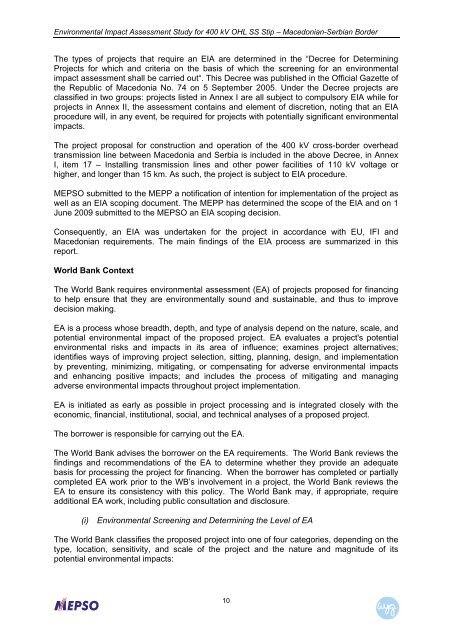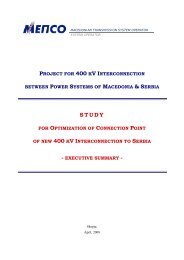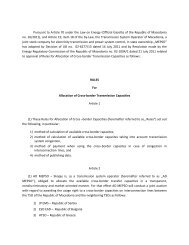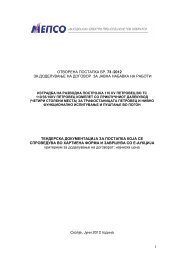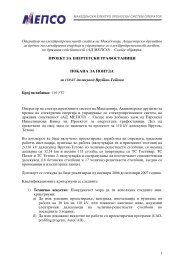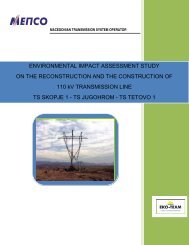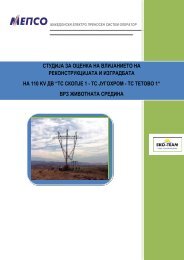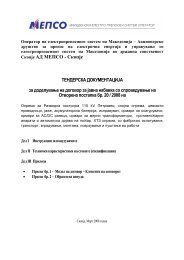Part A - EIA 400 kV OHTL Stp - мепÑо а.д.
Part A - EIA 400 kV OHTL Stp - мепÑо а.д.
Part A - EIA 400 kV OHTL Stp - мепÑо а.д.
You also want an ePaper? Increase the reach of your titles
YUMPU automatically turns print PDFs into web optimized ePapers that Google loves.
Environmental Impact Assessment Study for <strong>400</strong> <strong>kV</strong> OHL SS Stip – Macedonian-Serbian BorderThe types of projects that require an <strong>EIA</strong> are determined in the “Decree for DeterminingProjects for which and criteria on the basis of which the screening for an environmentalimpact assessment shall be carried out“. This Decree was published in the Official Gazette ofthe Republic of Macedonia No. 74 on 5 September 2005. Under the Decree projects areclassified in two groups: projects listed in Annex I are all subject to compulsory <strong>EIA</strong> while forprojects in Annex II, the assessment contains and element of discretion, noting that an <strong>EIA</strong>procedure will, in any event, be required for projects with potentially significant environmentalimpacts.The project proposal for construction and operation of the <strong>400</strong> <strong>kV</strong> cross-border overheadtransmission line between Macedonia and Serbia is included in the above Decree, in AnnexI, item 17 – Installing transmission lines and other power facilities of 110 <strong>kV</strong> voltage orhigher, and longer than 15 km. As such, the project is subject to <strong>EIA</strong> procedure.MEPSO submitted to the MEPP a notification of intention for implementation of the project aswell as an <strong>EIA</strong> scoping document. The MEPP has determined the scope of the <strong>EIA</strong> and on 1June 2009 submitted to the MEPSO an <strong>EIA</strong> scoping decision.Consequently, an <strong>EIA</strong> was undertaken for the project in accordance with EU, IFI andMacedonian requirements. The main findings of the <strong>EIA</strong> process are summarized in thisreport.World Bank ContextThe World Bank requires environmental assessment (EA) of projects proposed for financingto help ensure that they are environmentally sound and sustainable, and thus to improvedecision making.EA is a process whose breadth, depth, and type of analysis depend on the nature, scale, andpotential environmental impact of the proposed project. EA evaluates a project's potentialenvironmental risks and impacts in its area of influence; examines project alternatives;identifies ways of improving project selection, sitting, planning, design, and implementationby preventing, minimizing, mitigating, or compensating for adverse environmental impactsand enhancing positive impacts; and includes the process of mitigating and managingadverse environmental impacts throughout project implementation.EA is initiated as early as possible in project processing and is integrated closely with theeconomic, financial, institutional, social, and technical analyses of a proposed project.The borrower is responsible for carrying out the EA.The World Bank advises the borrower on the EA requirements. The World Bank reviews thefindings and recommendations of the EA to determine whether they provide an adequatebasis for processing the project for financing. When the borrower has completed or partiallycompleted EA work prior to the WB’s involvement in a project, the World Bank reviews theEA to ensure its consistency with this policy. The World Bank may, if appropriate, requireadditional EA work, including public consultation and disclosure.(i) Environmental Screening and Determining the Level of EAThe World Bank classifies the proposed project into one of four categories, depending on thetype, location, sensitivity, and scale of the project and the nature and magnitude of itspotential environmental impacts:10


